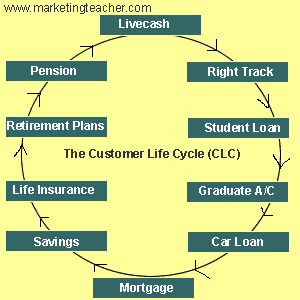The Customer Life Cycle (CLC) and CRM
The Customer Life Cycle (CLC) has obvious similarities with the Product Life Cycle (PLC). However, CLC focuses upon the creation of and delivery of lifetime value to the customer i.e. looks at the products or services that customers NEED throughout their lives.
The customer reviews models and books a test-drive with her or his local dealer. He or she decides to buy the car and arranges finance. The car is then delivered from the factory, and returns every year for its annual service. Then after three years, the customer decides to trade in his or her car, and the cycle begins again. The longer-term life cycle is simply the shorter-term life cycles viewed consecutively.
CRM is a term that is often referred to in marketing. However, there is no complete agreement upon a single definition. This is because CRM can be considered from a number of perspectives. In summary, the three perspectives are:
- Information Technology (IT) perspective
- The Customer Life Cycle (CLC) perspective
- Business Strategy perspective
Disclaimer:
Our model is a hybrid of many other commonly cited models from a number of sources. If you are undertaking higher-level academic work you need to clarify with your tutor, the nature of his or her preferred model.
It is marketing orientated rather than product orientated, and embodies the marketing concept. Essentially, CLC is a summary of the key stages in a customer’s relationship with an organisation. The problem here is that every organisation’s product offering is different, which makes it impossible to draw out a single Life Cycle that is the same for every organisation.

Let’s consider an example from the Banking sector. HSBC has a number of products that it aims at its customers throughout their lifetime relationship with the company. Here we apply a CLC. You can start young when you want to save money. 11-15 year olds are targeted with the Livecash Account, and 16-17 year olds with the Right Track Account. Then when (or if) you begin College or University there are Student Loans, and when you qualify there are Recent Graduate Accounts.
When you begin work there are many types of current and savings account, and you may wish to buy property, and so take out a mortgage. You could take out a car loan, to buy a vehicle to get you to work. It would also be advisable to take out a pension. As you progress through your career you begin your own family, and save for your own children’s education. You embark upon a number of savings plans and schemes, and ultimately HSBC offer you pension planning (you may want to insure yourself for funeral expenses – although HSBC may not offer this!).
This is how an organization such as HSBC, which is marketing orientated, can recruit and retain customers, and then extend additional products and services to them – throughout the individual’s life. This is an example of a Customer Life Cycle (CLC).
Another important point is that a lifetime CLC is made up many shorter CLC’s. So, for example, Volkswagen Cars retains a customer for many years and one can predict the products that meet a customers needs throughout his or her family lifetime. However the purchase of each car, will in itself be a CLC with many Customer Touch Points. The consumer may need a bigger vehicle as his or her family expands – so they visit VW’s website and register.
